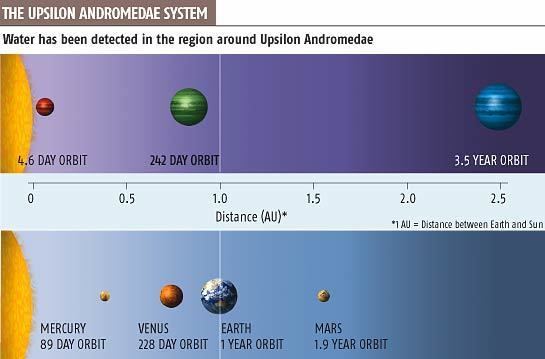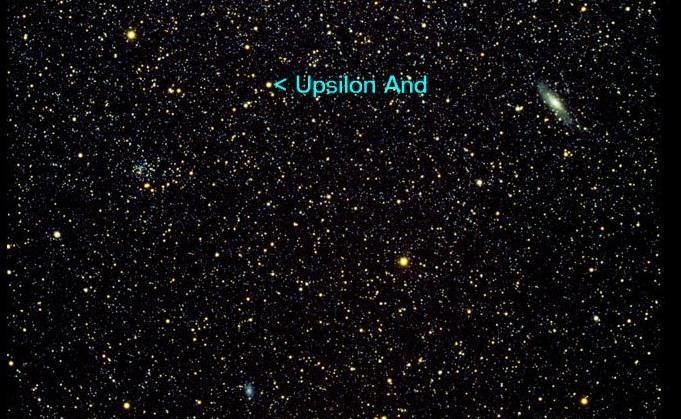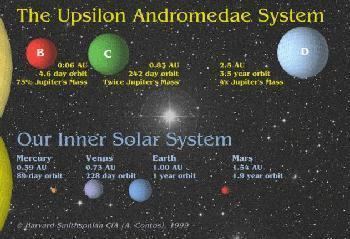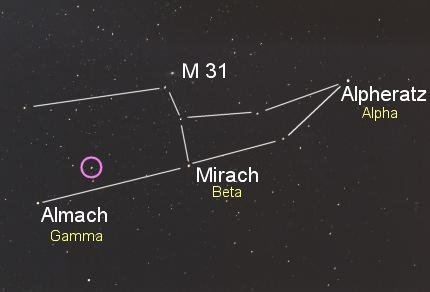Magnitude 4.09 Apparent magnitude (V) 4.09 | ||
 | ||
Similar Upsilon Andromedae b, Kappa Andromedae, Upsilon Andromedae d, 51 Pegasi, 47 Ursae Majoris | ||
Upsilon Andromedae (υ Andromedae, abbreviated Upsilon And, υ And) is a binary star located approximately 44 light-years from Earth in the constellation of Andromeda. The system consists of an F-type main-sequence star (designated υ Andromedae A, also named Titawin) and a smaller red dwarf (υ Andromedae B).
Contents
- Nomenclature
- Distance and visibility
- Upsilon Andromedae A
- Upsilon Andromedae B
- Planetary system
- References

As of 2010, four extrasolar planets (designated Upsilon Andromedae b, c, d and e; the first three named Saffar, Samh and Majriti, respectively) are believed to orbit υ Andromedae A. All four are likely to be jovian planets that are comparable in size to Jupiter. This was both the first multiple-planet system to be discovered around a main-sequence star, and the first multiple-planet system known in a multiple star system.

Nomenclature

υ Andromedae (Latinised to Upsilon Andromedae) is the system's Bayer designation. Under the rules for naming objects in binary star systems the two components are designated A and B. Under the same rules, the first planet discovered orbiting υ Andromedae A should be designated υ Andromedae Ab. Though this more formal form is occasionally used to avoid confusion with the secondary star υ Andromedae B, it is more commonly referred to as υ Andromedae b. The other planets discovered were designated υ Andromedae c, d and e, in order of their discovery.

In July 2014 the International Astronomical Union (IAU) launched a process for giving proper names to certain exoplanets and their host stars. The process involved public nomination and voting for the new names. In December 2015, the IAU announced the winning names were Titawin for υ Andromedae A and Saffar, Samh and Majriti for three of its planets (b, c, and d, respectively).

The winning names were those submitted by the Vega Astronomy Club of Morocco. The star is named after the settlement in northern Morocco and UNESCO World Heritage Site now known as the medina (old town) of Tétouan. The planets honour the 10th and 11th Century astronomers Ibn al-Saffar, Ibn al-Samh and Maslama al-Majriti of Muslim Spain.

In 2016, the IAU organized a Working Group on Star Names (WGSN) to catalog and standardize proper names for stars. In its first bulletin of July 2016, the WGSN explicitly recognized the names of exoplanets and their host stars approved by the Executive Committee Working Group Public Naming of Planets and Planetary Satellites, including the names of stars adopted during the 2015 NameExoWorlds campaign. This star is now so entered in the IAU Catalog of Star Names.
In Chinese, 天大將軍 (Tiān Dà Jiāng Jūn), meaning Heaven's Great General, refers to an asterism consisting of Upsilon Andromedae, Gamma Andromedae, Phi Persei, 51 Andromedae, 49 Andromedae, Chi Andromedae, Tau Andromedae, 56 Andromedae, Beta Trianguli, Gamma Trianguli and Delta Trianguli. Consequently, Upsilon Andromedae itself is known as 天大將軍六 (Tiān Dà Jiāng Jūn liù, English: the Sixth Star of Heaven's Great General.).
Distance and visibility
Upsilon Andromedae is located fairly close to the Solar System: the parallax of Upsilon Andromedae A was measured by the Hipparcos astrometry satellite as 74.12 milliarcseconds, corresponding to a distance of 13.49 parsecs (44 light years). Upsilon Andromedae A has an apparent magnitude of +4.09, making it visible to the naked eye even under moderately light-polluted skies, about 10 degrees east of the Andromeda Galaxy. The dimmer star Upsilon Andromedae B is only visible with a telescope.
Upsilon Andromedae A
Upsilon Andromedae A is a yellow-white dwarf of spectral type F8V, similar to the Sun, but younger, more massive, and more luminous. According to its entry in the Geneva–Copenhagen survey, the star is around 3.1 billion years old, and has a similar proportion of iron relative to hydrogen to the Sun. At around 1.3 solar masses, it will have a shorter lifetime than the Sun. The amount of ultraviolet radiation received by any planets in the star's habitable zone would be similar to the ultraviolet flux the Earth receives from the Sun.
Upsilon Andromedae A was ranked 21st in the list of top 100 target stars for NASA's cancelled Terrestrial Planet Finder mission.
Upsilon Andromedae B
Upsilon Andromedae B is a red dwarf of spectral type M4.5V located at a projected separation of 750 AU from the primary star. The true separation between the two stars is unknown because the displacement along the line of sight between Earth and the Upsilon Andromedae stars is unknown, so this value is a minimum separation. Based upon its motion through space, this is a common proper motion companion to the primary. It was discovered in 2002 in data collected as part of the Two Micron All Sky Survey. The star is less massive and far less luminous than the Sun.
The Washington Double Star Catalog lists two optical components; however, these do not share the system's proper motion and only appear close to Upsilon Andromedae because they happen to lie near the same line of sight.
Planetary system
The star rotates at an inclination of 58+9
−7 degrees relative to Earth.
The innermost planet of the Upsilon Andromedae system was discovered in 1996 and announced in January 1997, together with the planet of Tau Boötis and the innermost planet of 55 Cancri. The discovery was made by Geoffrey Marcy and R. Paul Butler, both astronomers at San Francisco State University. The planet, designated Upsilon Andromedae b, was discovered by measuring changes in the star's radial velocity induced by the planet's gravity. Because of its closeness to the parent star, it induced a large wobble which was detected relatively easily. The planet appears to be responsible for enhanced activity in the chromosphere of its star.
Even when this planet was taken into account, there still remained significant residuals in the radial velocity measurements, and it was suggested there might be a second planet in orbit. In 1999, astronomers at both San Francisco State University and the Harvard-Smithsonian Center for Astrophysics independently concluded that a three-planet model best fit the data. The two outer planets were designated Upsilon Andromedae c and Upsilon Andromedae d in order of increasing distance from the star. Both of these planets are in more eccentric orbits than any of the planets in the Solar System (including Pluto). Upsilon Andromedae d resides in the system's habitable zone.
The system is not coplanar, with each other or with the stellar rotation. The mutual inclination between c and d is 30 degrees. In 2001, preliminary astrometric measurements suggested the orbit of the outermost planet is inclined at 155.5° to the plane of the sky. However, subsequent investigation of the data reduction techniques used suggests that the Hipparcos measurements are not precise enough to adequately characterize the orbits of substellar companions. Astrometry of the innermost planet, meanwhile, constrained its inclination to 30-90 degrees. Full publication is expected in 2008. The orbit of Upsilon Andromedae c gradually oscillates between circular and eccentric states every 6,700 years. The existence of further planets too small or distant to detect has not been ruled out, though the presence of Jupiter-mass planets as close as 5 AU from Upsilon Andromedae A would make the system unstable.
Some simulations show that the eccentricity of the system's planets may have arisen from a close encounter between the outer planet and a fourth planet, with the result that the fourth planet was ejected from the system or destroyed. If so, the rogue planet would have had to eject immediately; it is unclear how likely this situation might be. Other models are possible. However, a fourth planet (Upsilon Andromedae e) was discovered in 2010. This planet is in a 3:1 resonance with Upsilon Andromedae d.
Upsilon Andromedae does not appear to have a circumstellar dust disk similar to the Kuiper belt in the Solar System. This may be the result of perturbations from the companion star removing material from the outer regions of the Upsilon Andromedae A system.
